
"Better Neighbourhoods - Making higher densities work" (CABE)
.pdf
2/Benefits
‘The compact city and intensive development does not necessarily imply high rise buildings. London has achieved some of its highest residential densities in relatively low rise areas, while isolated, poorly designed tower blocks have not necessarily delivered high density or usable public space.’ 7
The success and sustainability of our towns and cities demonstrates the long-term viability of high density living.
Research by the London School of Economics in 2004 shows that higher density can bring benefits. Successful developments espouse Building for Life standards in terms of character; roads, parking and pedestrianisation; design and construction; and environment and community. Developers are achieving higher densities without sacrificing quality by building three storeys instead of two, choosing terraced instead of detached homes, or through building apartments for growing numbers of childless households.
To help the South East England Regional Assembly develop policies, and to produce The Councillors’ Toolbox on making the best use of land, URBED and MORI asked councillors in the region for their views. They identified benefits from higher densities in avoiding sprawl and protecting rural England, and in improving services.
Higher density housing can deliver social benefits
‘There is a real misunderstanding about what higher density housing is, particularly in the context of London and the South East. Many of the problems blamed on density are in fact
a combination of problems with location, design, tenure mix, allocation policies, lack of management and maintenance.
In the area we work in, higher density housing is not only necessary because land is scarce, but also desirable as it can deliver real social benefits. For example:
•much of the more desirable housing in urban areas is of a higher density design
•higher density housing in existing urban areas creates vibrant, successful neighbourhoods, and the number and variety of people who live there support local shops, transport and community facilities
•higher density neighbourhoods do not mean all higher density housing is the same (a combination of housing types allows for different designs at different times in a person’s or a family’s life), and
•higher density housing allows for private outdoor spaces and for shared spaces (such as parks) and shared facilities’
11

2/ Benefits
In the right circumstances, higher densities can produce a range of benefits such as:
Increasing value
Many of the areas we like to visit on holiday, such as historic towns and areas in city centres with the highest house prices, are in fact built at higher densities. Georgian residential areas are becoming popular again. Where land values are high, increased densities can help fund environmental improvements and the provision of affordable housing through Section 106 agreements.
Convenient shops and services
With more people living in an area, better local shops and schools become economically viable, as do regular bus services. Thus while 25 homes per hectare may be needed to support fairly
frequent bus services, double the number could support an express bus service within a quarter of a mile. Places that are not over-dependent on car use enjoy livelier streets and in turn create better neighbourhoods.
Safer streets
Streets that are overlooked by homes not only feel safer but are safer, with much lower rates of burglary. Slower car speeds, more walkers and cyclists mean it is safer for children to walk to school or play outside. Higher density development can increase site values, which in turn can provide higher-quality public spaces like Home Zones being introduced in some areas to provide safe outdoor playing space.
Design for living
If well-designed higher-density housing can respond to many demands of 21st century living, flexible layouts and
lifetime homes standards can be readily achieved. Most people want more space under their control.
Energy conservation
New houses cost less to heat than older houses thanks to better insulation and more efficient heating systems. Higher density homes further reduce energy losses and can include schemes to save natural resources such as Combined Heat and Power.
Mixed communities
In an effort to increase affordable housing, the ODPM wants far more mixed-tenure developments and now recommends more affordable housing in new schemes. The larger the scheme, the easier it is to provide a balance of tenures and house types. In town and city centres families may end up living
in flats, and careful design is required to make schemes work.
‘Somewhere not anywhere’
Higher density development makes it easier to create a sense of identity and place. When combined with greenery and attention to detail,
it can turn locations into desirable places. Far from reducing the quality of neighbourhoods, higher density housing can make them more distinctive and introduce a muchneeded element of diversity.
‘In many urban situations, medium rise, higher density buildings (of about 3-4 storeys) in general provide the optimum form that maximises density whilst minimising perceived intensity or overcrowding. They can also be designed to be attractive, energy efficient and mixed use whilst:
•Reducing costs of land acquisition and site infrastructure
•Avoiding costs of lifts and other services
•Providing a robust form that allows for changes in use over time
•Forming terraces or low rise flats, the most cost effective building form in housing
•Increasing energy efficiency and the ability to be oriented for passive solar gain
•Providing lifetime homes that can be readily adapted for the elderly or disabled.’8
12
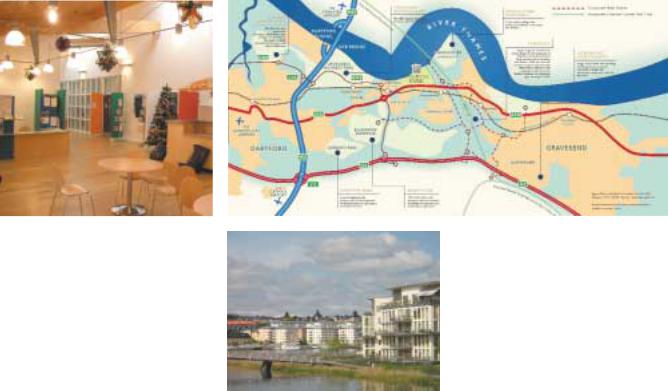
Case study: Oakridge
The new community centre sits at the heart of Oakridge, a regeneration of an overspill estate of four/fivestorey walk-up maisonettes and flats near to Basingstoke. A pub is also under construction and five shops are already operating successfully in prominent locations adjacent
to the main square, having been relocated from less well connected locations on the demolished estate. The new housing development also has a health visitor and nursery school on site and a regular bus service stops on the High Street and connects Oakridge to facilities in Basingstoke.
Case study: Hammarby Sjöstad
Hammarby Sjöstad was initially planned as the Olympic Village in Stockholm’s unsuccessful bid for the 2004 Olympic Games. Sufficient impetus built up within the city’s planning department and through investment in infrastructure for the scheme to proceed despite the failure of the Olympic bid. The resulting scheme reflects the desire of the city of Stockholm to provide high quality and higher density homes which benefit from excellent levels of sustainability together with new transportation and infrastructure. Once the phased
development is completed, Hammarby Sjöstad will provide 9,000 mixed tenure homes at an average density of 145 dph. In addition there is a new school, church, shops, offices and a park all located on a 7.6 hectare brownfield site within easy reach of Stockholm’s inner city.
Case study: Ingress Park
Ingress Park, Greenhithe, is a sevenyear masterplanned development by Crest Nicholson Residential Limited. When complete, it will provide up to 950 homes, live-work units, a local shopping centre, community facilities and a site for a new school. It is being constructed on a 29 hectare brownfield site on the south side of the River Thames, about one mile east of the Dartford Crossing, and is set in grounds previously landscaped by Capability Brown surrounding the Grade II listed Ingress Abbey. The density of the development ranges from 40–150 dph.
13
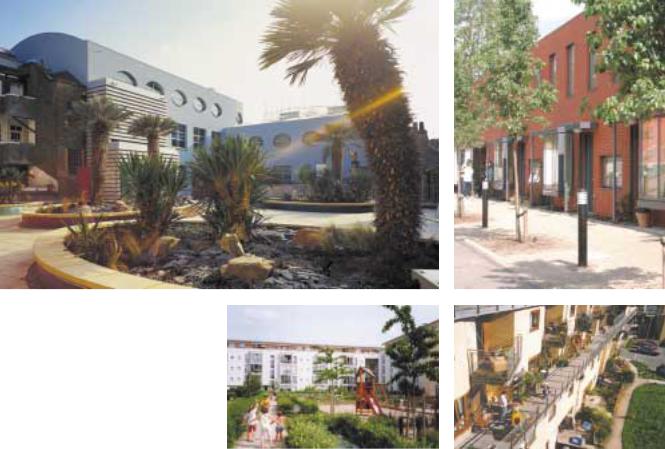
Case study: Fulham Island
Fulham Island is an innovative mixed-use scheme located in the heart of Fulham Broadway, west London, on a busy island site. Developed by Manhattan Loft Corporation Ltd
with CZWG Architects as designers, it provides retail, residential and commercial premises with 38 private
homes (22 new, 16 refurbished) at an average density of 132 dph. A major design objective was to deal with the entirety of the site (a ‘doughnut’ shape) and to clear out the messy central service area behind the existing buildings, which attracted anti-social behaviour, whilst retaining existing listed buildings. The resulting scheme is modern in design and creates interest and a sense of identity in a previously neglected area. Particularly notable are the vertical and horizontal mix of uses, and the provision of underground
car parking. The central area has been covered with a deck, which creates maximum retail space while also unifying the different elements of the scheme. It also provides an attractive garden for residents at first floor level.
Reiselfeld
Innovative housing in Reiselfeld, Freiburg, attracts families because children can play together safely.
Case study: Beaufort Court
Beaufort Court is located on Lillie Road in north Fulham and comprises 65 homes at an average density of 116 dph. The homes are a mix of terraced houses with gardens, maisonettes and flats with a community facility and a semiunderground car park covered by
a fenced kickabout pitch. Built and developed by the Peabody Trust on land bought from the local authority, the London Borough of Hammersmith and Fulham, the scheme provides a mixture of affordable tenures in an area of high housing costs and high demand.
Homes and Work for Change
Homes for Change in Hulme, Manchester, provides housing above workspace, with large decks.
14
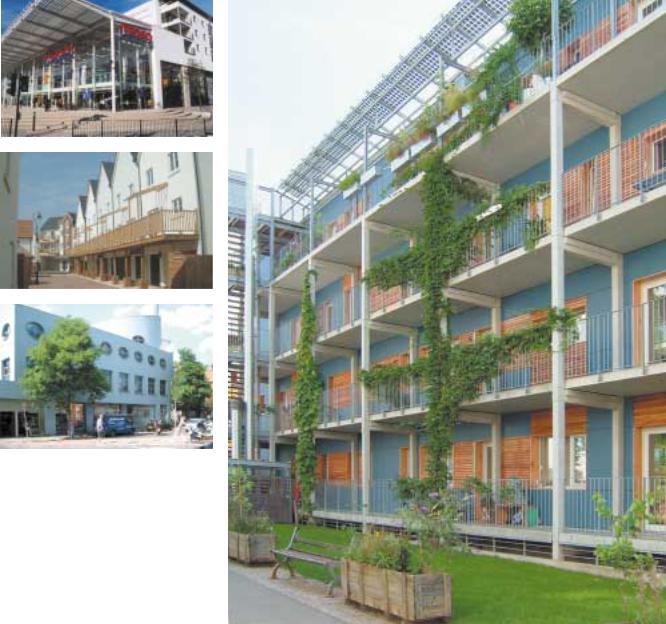
Earl’s Court
The air space above a superstore provides stylish housing in Earl’s Court.
Case study: Ingress Park |
|
At Ingress Park, Greenhithe, the |
|
overall development is phased, |
|
moving generally west to east across |
|
the site. The density of the phases |
|
and the architectural approach in |
|
each is varied, creating different |
|
senses of character across the site. |
Vauban |
Place and context are at the heart of |
Continental blocks of flats, like these |
this approach, with high-level |
in Vauban in Freiburg, use solar |
investment in the public realm to |
panels to reduce heating costs. |
enhance the setting. |
|
Case study: Fulham Island |
|
As Fulham Island incorporates a mix |
|
of uses, and both refurbishment and |
|
new build, affordable housing in this |
|
case would not have been viable. |
|
15

3/Barriers
The term ‘high density’ is in itself a barrier in terms of public perception. This is partly because of the association between higher density housing, and high-rise system-built housing estates suffering from physical and social problems. There is also a belief that higher density additions to a neighbourhood are unlikely to make
it a better place to live. Understandably, people can see disadvantages if more residents compete for the same schools, the same public transport, and the same parking spaces. The significant advantages of higher density can be much harder to see at first, and only become apparent when there are successful models that show how
good high density can be.
There are also a number of other common issues which need to be addressed if we are to build better neighbourhoods:
Distrust and conflict
Plenty of schemes appear to comply with government policy but are turned down at planning stage. If the relationship between local authorities and developers is not based on mutual understanding and
cooperation, it may be easier for authorities to reject schemes rather than to seek improvements. However fighting public inquiries ties up resources that could be better used in improving the quality of the design in the first place, and can also inhibit later flexibility.
Institutional inertia
We have only recently changed how we look at towns and cities. The 2000 Urban White Paper, Our Towns and Cities: the Future, was a turning point in its view of towns as assets not just liabilities, but it takes time for new ideas to take hold.
The White Paper supported the earlier Urban Task Force vision of urban renaissance as places where people want to live out of choice, not necessity. This led to other guidance at regional level aimed at changing how we build. Many councils are now changing how they assess schemes, but this demands an adjustment in staff attitudes, not
just rewriting planning policies. New policies can be daunting but more positive planning could make working
in the built environment a much more attractive career.
Lack of capacity
A more fundamental barrier to higher density housing is the overloaded transport, service and social infrastructure that exists in many places. Add to this articulate local opposition to traffic problems, school and teacher shortages and a lack of health staff and facilities. One solution is to ensure developers
and schemes contribute to increasing capacity, through planning obligations as well as providing affordable housing or the likes of teachers and health workers. In London, density guidelines are highest around town centres, and where there is most public transport, and it makes general sense to promote a ‘density gradient’.
Design challenges
Complaints by councillors and residents about poor quality homes are borne out by CABE’s Housing Audit. Good design may cost more but there is evidence it can add much more in terms of value.
The top 10 biggest barriers to building higher density development in the South East
Concerns about the impact on traffic and parking |
|
62% |
One quarter (26%) say this is the biggest barrier |
Local residents are not in favour 51%
‘Out of character’ with the local area 44%
Concerns about the impact on local services (eg schools, hospitals) 39%
Concerns about the lack of poor public spaces and play areas within the developments 20%
Associated with ‘problem’ families 16%
Local Councillors not in favour 12%
Perceived to be ugly 11%
Perceived to reduce house prices for current residents 9%
Other
8%
16
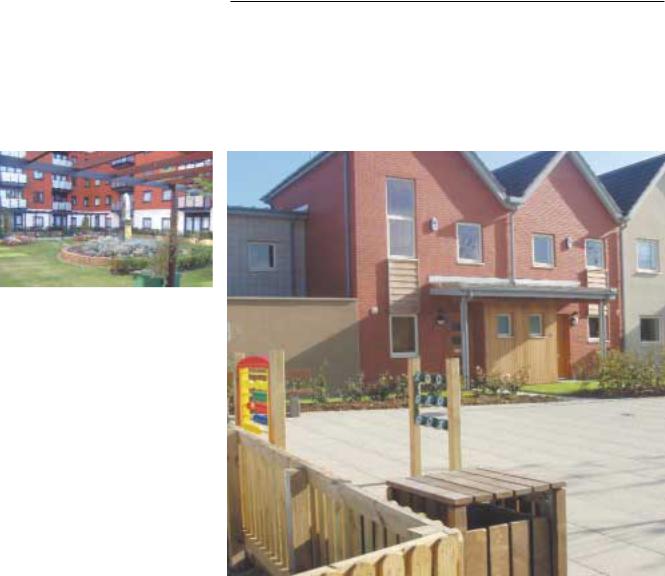
3/ Barriers
Charter Quay
Charter Quay, Kingston, has underground parking to keep cars out of the way, and provide public gardens above.
The Staiths
The Staiths, South Bank. Distinctive new housing in Gateshead with high quality, landscaped public space.
Too often, issues over design get bogged down in pointless arguments over style or detailing, when there are more important design issues to resolve:
•Parking New housing in locations that are badly served by public transport require more parking, but this should be carefully integrated to avoid cars dominating the public realm. Underground or multi-storey parking becomes viable at densities over 100 dph. Intelligent design needs to be employed in developments of medium densities of 30 to 100 dph, where underground parking is not viable.
•Privacy Acoustic and visual privacy are a major worry about higher density living. Careful planning to design out problems of overlooking and better methods of insulation are needed.
•Mixed uses Planners often want multifunctional neighbourhoods but this does not have to involve different uses in one building. Higher density building
alongside existing town and local centres, or even redeveloping redundant space in retail and business parks, allows a balance of uses without conflict.
•Mixed communities Even more important is maintaining and improving the balance between household types and tenures. While locations will differ in their basic appeal, a carefully planned mix of tenures can entice renters to become owners and vice versa. It can enable people at different life stages
to find appropriate accommodation without moving far.
•Management Higher density housing requires ongoing management at block and neighbourhood level if standards are to be maintained and rubbish, graffiti and deterioration are to be avoided.
As in any well-managed estate, an agreement on standards and service charges can reduce risks and maintain the value of the investment.
17
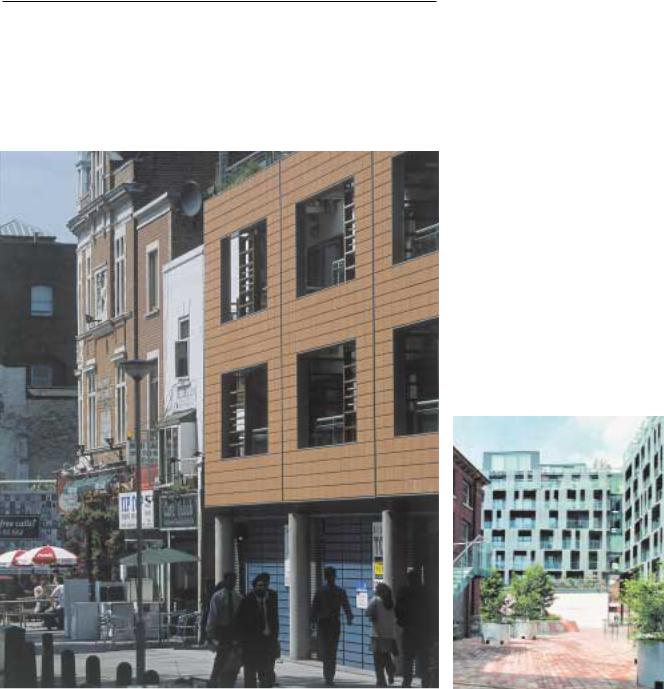
4/Key factors for success
‘Successful higher density housing has four key factors
– location and sense of place, a successful allocation policy and occupancy, successful management approach and good design.’9
The benefits of higher densities need to be clearly communicated to overcome negative attitudes and misunderstandings that can block development. Consensus and collaborative working is needed between different parts of the public sector, between local authorities and developers, and also to win over local communities. One size does not fit all, and density standards have to suit
the site.
Below we draw out five major lessons that form the basis for agreements between local authorities and house builders. These have been drawn from case studies of a selection of recent successful
higher density schemes that illustrate different approaches in different contexts, plus influential schemes in other parts
of the country which are providing fresh ideas on higher density design and layout.
Understand the economics of the scheme
Housing intensification is financially complex. Schemes vary enormously, even in the same area. Financial realism is essential when it comes to negotiating community benefits, as not only development costs differ (for example,
in their requirements for decontamination or new infrastructure) but so too do likely values and development risks.
Chronos
Chronos in Whitechapel exploits a location near the underground station.
Brewery Square
Brewery Square in Clerkenwell reinforces the idea of it being an ‘urban village’.
18

4/ Key factors for success
Case study: Fulham Island
Despite potential opposition from local amenity groups, the Fulham Island scheme owes much of its success to the vision and experience of Manhattan Loft Corporation and to the support of the local authority. Due to their inherent complexity the delivery and funding of high quality mixed-use schemes requires an innovative approach by developers. Manhattan Loft Corporation’s experience and commitment was instrumental in the successful delivery of Fulham Island. A ‘handson’ approach to resolving such issues
as existing occupiers, conflicting uses, access, amenity provision and local objectors, will help the successful delivery of mixed use schemes. Manhattan Loft arranged short-term leases and ensured that the scheme as a minimum ‘stood still’ financially while they dealt proactively with design, planning and consultation issues.
Close relationships between developers, planners and architects can allow innovation and aid delivery. The planners at the London Borough of Hammersmith and Fulham supported the innovative mixed
use scheme once Manhattan Loft and their architect had demonstrated the quality of their initial vision and design ideas.
Local authorities can help to understand the economics and bring forward viable sites by:
•Undertaking housing potential/capacity studies to assess all main sources of new housing in an area, including sites such as properties above shops or under-used car parks
•Reviewing policies covering land use and providing use and density guidelines for different kinds of area (as the Greater London Authority’s London Plan has done, for example)
•Working with landowners and/or house builders to prepare masterplans or development frameworks for
areas ripe for regeneration or neighbourhood revival
Once there is agreement on where new housing is to go, house builders may want to share information on the
economics of schemes on a confidential basis, as they already do, for example, when they are working in partnership with public agencies or are applying for grants.
Build consensus through collaborative working
Density is contentious. Sustainable communities cannot be built in the most efficient and effective way if local authorities and developers are locked in conflict and local grievances go unresolved.
Existing communities may be averse to additional housing. Collaborative
working is needed not only on large sites that may take years to develop, but also on complex sites where the risks inherent in assembling land and building infrastructure are high.
Local authorities can improve the process by:
•Showing leadership by advocating well designed higher densities
•Engaging local communities early on, particularly in creating Local Development Frameworks
•Holding pre-application meetings on major developments (more than 10 homes)
•Meeting house builders and professionals on a regular basis, for example through a housing forum
•Organising study tours to learn from relevant projects
•Using the new planning system to develop the vision and masterplan for the intensified development, setting out the community’s needs ahead of negotiations with specific developers
House builders can help in the way they consult the local community, and through the information they make available,
for example by:
•Finding out local concerns before designs are finalised
•Making available the results of viability studies on a confidential basis.
‘Modern masterplanning for higher density housing
should be a robust but flexible process that allows design
to evolve in response to changing circumstances, while at the same time achieving a relatively unified and consistent architectural approach.’10
19
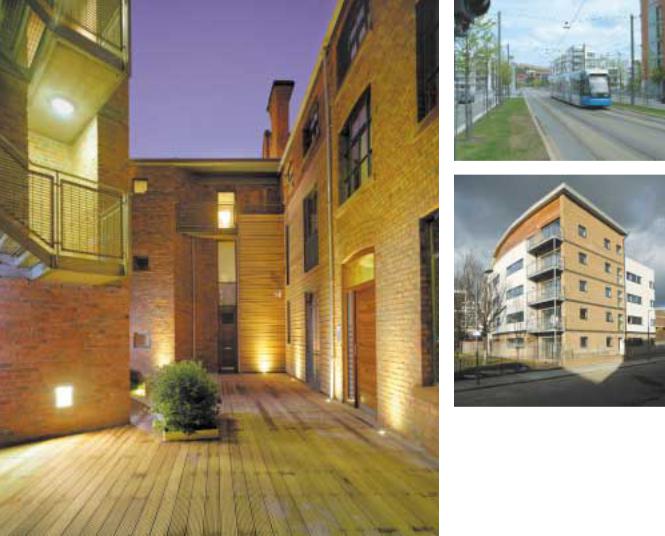
Case study: Old Haymarket
The redevelopment of this site has been described as a ‘textbook approach to urban renewal’. The
site is located in Liverpool city centre. The owners, Liverpool City Council, granted Urban Splash a 999-year lease on the site after they won
the project through a development competition in 1996. The relationship between the council and Urban Splash has been good and positive throughout. Liaison with the local authority was sought at an early stage, as the buildings are located
within a designated conservation area. The development has excellent access to all central shops, offices, hotels and leisure facilities. No affordable housing was actually required under the terms of the lease, but Urban Splash thought it would be beneficial to creating diversity in the area. A number of the apartments, therefore, were sold by Maritime Housing on a shared ownership basis, the first joint venture for Urban Splash.
Case study: Hammarby Sjöstad
Hammarby Sjöstad is an example of how collaborative working can achieve high standards of design, spacious apartments and superb open spaces. An integrated, multidisciplinary project team working towards shared goals can be
instrumental in achieving successful delivery of intensification. The City of Stockholm established a dedicated project team for Hammarby Sjöstad responsible for all aspects of the project. Agreement on transport infrastructure at Hammarby Sjöstad was instrumental in moving the project from vision to reality.
Case study: Limehouse
Limehouse Cut in Tower Hamlets, east London is an example of how successful community engagement and collaborative teamwork can result in the delivery of new homes and can aid neighbourhood regeneration. The regeneration programme implemented by Poplar HARCA (Poplar Housing and Regeneration Community Association) in the Limehouse
Cut area identified refurbishment, redevelopment and infill opportunities with a view to realising the potential of Bartlett Park, the nearest green space, and of the Limehouse Cut waterway that passes through the neighbourhood. The project comprises a series of small infill schemes
rather than a single development. The objective has been to develop small sites in the Limehouse area of Tower Hamlets to diversify housing tenure, generate income for the client, Poplar HARCA, while at the same time removing areas of redundant, underused land that attract antisocial behaviour.
20
